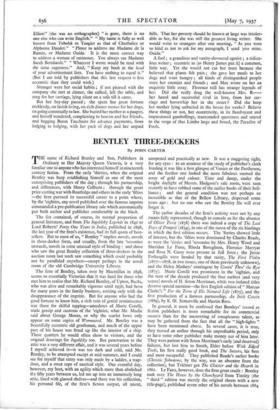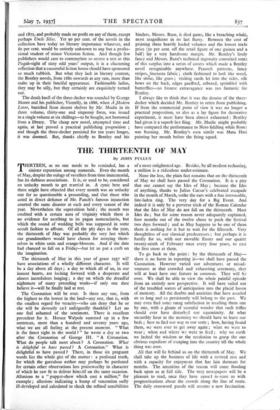BENTLEY THREE-DECKERS
By JOHN CARTER
The list contained, of course, its normal proportion of general literature, and from The Ingoldsby Legends in 1840 to Lord Roberts' Forty One Years in India, published in 1898, the last year of the firm's existence, had its full quota of best- sellers. But to most of us, " Bentley " implies novels, novels in three-decker form, and usually, from the late 'seventies onwards, novels in some unusual style of binding : and those who saw the great Bentley collection of three-deckers in the auction room last week saw something which could probably not be paralleled anywhere—except perhaps in the novel room of the old Cambridge University Library.
The firm of Bentley, taken over by Macmillan in 1898, seems so essentially Victorian that it was hard for those who met him to realise that Mr. Richard Bentley, of Upton, Bucks, who was alive and remarkably vigorous until 1936, had been for many years in the family business, retiring only with the disappearance of the imprint. But for anyone who had the good fortune to know him, a rich vein of genial reminiscence was there for skilful tapping—anecdotes of Marie Corelli, trade gossip and customs of the 'eighties, what Mr. Mudie said about George Moore, or why the scarlet bows only appear on some copies of Wormwood. Mr. Bentley was a beautifully eccentric old gentleman, and much of the upper part of his house was fitted up like the interior of a ship. These quarters he would often show to visitors, and the original drawings for Ingoldsby too. But penetration to the attic was a very different affair, and it was several years before I myself achieved it—it was too dark and cold, said Mr. Bentley, to be attempted except at mid-summer, and I could see for myself that entry was only made by a ladder, a trap- door, and a stout rope of nautical style. One eventful day, however, my host, with an agility which more than abolished tle fifty years between us, led me up into an immensely long attic, lined with glassed shelves—and there was his collection, his personal file, of the firm's fiction output, all uncut, unopened and practically as new. It was a staggering sight, for any eyes : to an amateur of the study of publisher's cloth binding it was like a first glimpse of Venice or the Parthenon, and the further one looked the more fabulous seemed the array of gold and colour. Time and damp, tinder the bright daylight of Messrs. Hodgson's sale room, were seen recently to have robbed some of the earlier books of their bril- liance; and the general condition was not perhaps so incredible as that of the Bellew Library, dispersed some years ago : but no one who saw the Bentley file will ever forget it.
The earlier decades of the firm's activity were not by any means fully represented, though to console us for the absence of Oliver Twist (1838) there was indeed a copy of The Last Days of Pompeii (1834), in one of the rarest of the six bindings in which the first edition occurs. The 'forties showed little of interest, but the 'fifties were dominated by Charles Reade, as were the 'sixties and 'seventies by Mrs. Henry Wood and Sheridan Le Fanu, Rhoda Broughton, Florence Marryat and Rosa N. Carey were present in full force ; the Jessie Fothergills were headed by that rarity, The First Violin (1877-1878, in two issues, one of them previously unknown), and the Helen Mathers' contingent by Comin' Thro' the Rye (1875). Marie Corelli was prominent in the 'eighties, and the turn of the decade produced the four earliest (and very scarce) novels of H. Seton Merriman, while two isolated titles deserve special mention—the first English edition of" Marcus Clarke's " For the Term of His Natural Life (1875), and the first production of a famous partnership, An Irish Cousin (1889), by E. G. Somerville and Martin Ross.
In general, it must be confessed that Bentleys' record as fiction publishers is more remarkable for its commercial success than for the uncovering of conspicuous talent, as may be gathered from the fact, that all the " high-lights " have been mentioned above. In several cases, it is true, they nursed an author through his unprofitable period, only to have some other publisher make money out of him later. They were patient with Sewn Merriman's early (and deserved) failures, but lost him to Smith, Elder before With Edged Tools, his first really good book, and The Sowers, his best and most sucqessful. They published Reade's earlier books (Christie johnscone, by the way, was an absentee from the collection), but Trilbner got The Cloister and the Hearth in 186/. Le Fanu, however, does the firm great credit : Bentley took over The House by the Churchyard from Tinsley (the " third " edition was merely the original sheets with a new title-page), published seven other of his novels between 1864 and 1872, and probably made no profit on any of them, except perhaps Uncle Silas. Yet 90 per cent. of the novels in the collection have today no literary importance whatever, and 8o per cent. would be entirely unknown to any but a profes- sional student of minor Victorian fiction. And though few publishers would care to contemplate so severe a test as this Pisgah-sight of sixty odd years' output, it is a chastening reflection that a successful fiction house should have sponsored so much rubbish. But what they lack in literary content, the Bentley novels, from 188o onwards at any rate, more than make up in their fanciful appearance. Fashionable ladies, they may be silly, but they certainly are exquisitely turned out.
The death knell of the three-decker was sounded by George Moore and his publisher, Vizetelly, in 1886, when A Modern Lover, banished from decent shelves by Mr. Mudie in its three volume, thirty-one and sixpenny form, was issued in a single volume at six shillings—to be bought, not borrowed from a library. The cheap new novel, attempted time and again, at last proved a practical publishing proposition ; and though the three-decker persisted for ten years longer, it was doomed. But, thanks chiefly to Bentley and his binders, Messrs. Burn, it died game, like a breaching whale, most magnificent in its last flurry. Between the cost of printing three heavily leaded volumes and the lowest trade price (50 per cent. off the retail figure of one guinea and a half) lay a very handsome margin. Mr. Bentley's lively fancy and Messrs. Burn's technical ingenuity converted some of this surplus into a series of covers which made a Bentley novel recognisable anywhere. Peacock patterns, fancy stripes,.lincrusta fabric ; cloth fashioned to look like wood, like stone, like grass ; visiting cards let into the sides, silk bows on the back, edges gauffred, zebraed, sprinkled with butterflies—no bizarre extravagance was too fantastic for Bentley.
I always like to think that it was the demise of the three- decker which decided Mr. Bentley to retire from publishing. If from the commercial point of view it was no longer a practical proposition, so also as a lay figure for decorative experiment, it must have been almost exhausted : Bentley had given it a superb last fling. Mr. Mudie might probably have compared the performance to Nero fiddling while Rom: was burning. Mr. Bentley's own simile was Mata Han painting her mouth before the firing squad.















































 Previous page
Previous page